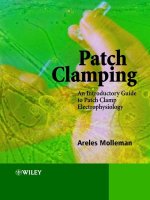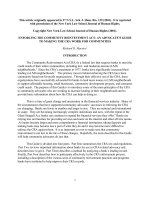Patch Clamping An Introductory Guide to Patch Clamp Electrophysiology pot
Bạn đang xem bản rút gọn của tài liệu. Xem và tải ngay bản đầy đủ của tài liệu tại đây (6.69 MB, 188 trang )
Patch Clamping
An Introductory Guide to Patch Clamp
Electrophysiology
Areles Molleman
University of Hertfordshire, UK
Patch Clamping
Patch Clamping
An Introductory Guide to Patch Clamp
Electrophysiology
Areles Molleman
University of Hertfordshire, UK
Copyright
©
2003JohnWiley&SonsLtd,TheAtrium,SouthernGate,Chichester,WestSussex
PO19 8SQ, England
Telephone (+44) 1243 779777
Email (for orders and customer service enquiries):
Visit our Home Page on www.wileyeurope.com or www.wiley.com
All Rights Reserved. No part of this publication may be reproduced, stored in a retrieval system or
transmitted in any form or by any means, electronic, mechanical, photocopying, recording, scanning
or otherwise, except under the terms of the Copyright, Designs and Patents Act 1988 or under the
terms of a licence issued by the Copyright Licensing Agency Ltd, 90 Tottenham Court Road, London
W1T 4LP, UK, without the permission in writing of the Publisher. Requests to the Publisher should be
addressed to the Permissions Department, John Wiley & Sons Ltd, The Atrium, Southern Gate,
Chichester, West Sussex PO19 8SQ, England, or emailed or , or faxed to (+44)
1243 770571.
This publication is designed to provide accurate and authoritative information in regard to the subject
matter covered. It is sold on the understanding that the Publisher is not engaged in rendering
professional services. If professional advice or other expert assistance is required, the services of a
competent professional should be sought.
John Wiley & Sons Inc., 111 River Street, Hoboken, NJ 07030, USA
Jossey-Bass, 989 Market Street, San Francisco, CA 94103-1741, USA
Wiley-VCH Verlag GmbH, Boschstr. 12, D-69469 Weinheim, Germany
John Wiley & Sons Australia Ltd, 33 Park Road, Milton, Queensland 4064, Australia
John Wiley & Sons (Asia) Pte Ltd, 2 Clementi Loop #02-01, Jin Xing Distripark, Singapore 129809
John Wiley & Sons Canada Ltd, 22 Worcester Road, Etobicoke, Ontario, Canada M9W 1L1
Library of Congress Cataloging-in-Publication Data
Molleman, Areles.
Patch clamping : an introductory guide to patch clamp electrophysiology / Areles Molleman.
p. cm.
Includes bibliographical references and index.
ISBN 0 471 48685 X
1. Patch-clamp techniques (Electrophysiology) I. Title.
QP341.M684 2002
572’.437 — dc21
2002027413
British Library Cataloguing in Publication Data
A catalogue record for this book is available from the British Library
ISBN 0 471 48685 X Paperback
Typesetin11/13
½
SabonbyKeytecTypesettingLtd
Printed and bound in Great Britain by TJ International, Padstow, Cornwall
This book is printed on acid-free paper responsibly manufactured from sustainable
forestry, in which at least two trees are planted for each one used for paper production.
OtherWileyEditorialOffices
Contents
Preface ix
1 Introduction 1
1.1 Patch Clamping and its Context 1
2 Basic Theoretical Principles 5
2.1 Introduction to Membrane Biology 5
2.1.1 The plasma membrane and its ionic environment 5
2.1.2 Electrochemical gradients and the Nernst equation 7
2.1.3 Maintenance of ion gradients and the membrane potential 8
2.1.4 Ion channels 11
2.2 Electrical Properties of th e Cell Membrane 13
2.2.1 Driving force and membrane resistance 13
2.2.2 Membrane capacitance 15
2.2.3 Consequences of membrane capacitance 16
2.2.4 An electronic model of the plasma membrane 17
2.3 Recording Modes and their Equivalent Circuits 18
2.3.1 The basics of equivalent circuits 18
2.3.2 Intracellular recording
2.3.3 Voltage clamp and current clamp 28
2.3.4 Introduction to patch clamp configurations
2.3.5 The equivalent circuit for the cell-attached patch configuration
2.3.6 The equivalent circuit for the whole-cell configuration 39
2.3.7 The equivalent circuit for the excised patch configurations
3 Requirements 43
3.1 The Platform 43
3.1.1 Stability: vibrations and drift 43
3.1.2 Where in the building should the set-up be placed? 44
3.1.3 Anti-vibration tables 45
3.2 Mechanics and Optics 47
3.2.1 The microscope 48
23
31
37
41
3.2.2 Micromanipulators 52
3.2.3 Pipette pressure 56
3.2.4 Baths and superfusion systems 57
3.3 Electrodes and Micropipettes 64
3.3.1 Solid–liquid junction potentials and polarisation 65
3.3.2 The bath electrode 67
3.3.3 Micropipettes 67
3.3.4 Liquid junction potentials 74
3.4 Electronics 75
3.4.1 External noise and Faraday cages 76
3.4.2 Patch clamp amplifiers 81
3.4.3 Noise prevention and signal conditioning 84
3.4.4 Data acquisition and digitisation 90
3.4.5 Computers and software 93
4 The Practice of Patch Clamping 95
4.1 Preparing the Experiment and Making a Seal 95
4.1.1 Setting up 95
4.1.2 Bringing the pipette near the preparation 98
4.1.3 Making the seal 101
4.2 Whole-cell Modes 104
4.2.1 Conventional whole-cell recording 104
4.2.2 Perforated patch recording 108
4.3 Single-channel Modes 110
4.3.1 General notes 110
4.3.2 Cell-attached patch 112
4.3.3 Excised patches 113
5 Whole-cell Protocols and Data Analysis
5.1 Standard Cellular Parameters
5.2 Voltage-activated Currents 116
5.2.1 Introduction to pulse protocols 116
5.2.2 Signal conditioning and positive/negative subtraction 119
5.2.3 Space clamp artefacts 123
5.2.4 Isolation of a homogeneous population of channels 126
5.2.5 Current–voltage relationships and reversal potential 127
5.2.6 Determination of relative permeabilities 131
5.2.7 Activation and inactivation studies 132
5.3 Non-voltage-activated Currents 137
5.3.1 Introduction to continuous recording 137
5.3.2 Determination of reversal potential using voltage ramps 138
6 Single-channel Protocols and Data Analysis 141
6.1 General Single-channel Practice and Analysis 141
6.1.1 Practical notes 141
6.1.2 Amplitude analysis 143
6.1.3 Event detection 148
vi CONTENTS
115
115
6.1.4 Dwell time analysis 152
6.2 Continuous Recording of Single Channels 157
6.2.1 Data acquisition 157
6.2.2 Spontaneous activity 158
6.2.3 Receptor-induced activity 160
6.3 Study of Single-voltage-dependent Channels 160
6.3.1 Step protocols 160
6.3.2 Ramp protocols 162
6.3.3 Correlation with macro-currents 164
Further Reading 167
Index 171
vii
Preface
Since the advent of patch clamp electrophysiology at the end of the 1970s,
there has been an ever-increasing interest in the application of its power to
investigate ion-channel-related bioscientific questions in unprecedented
detail. Whereas patch clamping was pioneered in specialist biophysical
laboratories,latertherewasanexpansiontomanyotherfieldsinbiology,
as well as to basic research in medicine and related areas. This has not
occurred without problems: patch clamping was developed by biologists
who were strongly orientated towards physics and who were collaborating
closely with engineers and physicists. In the expansion to traditionally less-
clamping are fundamentally different from the mostly chemistry-based
work that is performed there. Many undergraduate biosciences pro-
grammes have been slow to react to this situation, sometimes owing to the
lack of experienced lecturers. Even if expert teachers are available, the
absence of an appropriate textbook makes it hard for the teachers to
communicatethebasicconcepts.Consequently,itisoftendifficultfor
researchers to recruit workers with the appropriate training to perform
patch clamping. At the same time researchers who are considering using
patchclampingintheirworkcanfindithardtoevaluatetheimplications
if they lack training and experience themselves.
Textbooks on patch clamping are too general for practical laboratory
use or are written for experienced biophysicists. Most of them also have a
format in which each chapter is written by different authors who write
about their respective specialist areas, which inevitably means that the
books lack continuity if not coherence. This book is intended to provide,
in a single coherent volume, the basic knowledge and an overview of the
materials, skills and procedures required to start patch clamping success-
fully. The book is written for those who are novices at patch clamping but
have some background in Biology or Medical Sciences, be they final-year
biophysical elds it is very apparent that concepts and methods in patch
fi
undergraduate or MSc/PhD students, post-doctoral researchers or estab-
lished workers from other fields who may require help in the concepts of
electronics, for example. A portion of the book is therefore spent on this
subject with the emphasis on relevance to membrane biology. The book
also should be useful as a basic method reference, particularly in relation
to data acquisition protocols and analysis.
One of the developments since the expansion of patch clamping into a
wider field has been that equipment and software have become much more
commercially available and ‘user-friendly’. The unfortunate side-effect of
this has been that it has become easier to work with the equipment, obtain
data and have them analysed automatically without the experimenter
evaluating the validity of the results or the analysis. Although this is a
problem with all automated systems, from statistics software to nuclear
magnetic resonance spectral analysis, in patch clamping there are many
stages in which input (judgement) from the experimenter is required for
proper application of the equipment and analysis techniques. The right
input comes with experience and appreciation of the experimental situa-
tion. This book is meant to provide the start of that appreciation.
The book is not a dictionary of patch clamping. The main fundamentals
are touched upon, but the level of discussion is measured to convey the
concepts in enough depth to apply in practice. There should then be
enough understanding to provide access to specialist literature if required.
A selection of this literature is listed in a ‘Further Reading’ section.
The success of this text should be measured by its ability to minimise the
number of other books that need to be studied, wheels reinvented and time
spent to master basic ideas before successful patch clamp recordings are
made. My hope is that this book will allow patch clamping to become a
rewarding pursuit for many more scientists.
Areles Molleman
x PREFACE
1
Introduction
1.1 Patch Clamping and its Context
The historical route to present-day patch clamping started with the
scientific recognition that electrical phenomena are part of animal physiol-
ogy. This bioelectricity was demonstrated in the nineteenth century in
frogs, where muscle movements could be evoked by applying electrical
stimuli to the animal. The recording of inherent electrical activity can be
charted by the development of increasingly sophisticated electrodes. Long
before anything was known about ion channels, membrane potentials
were recorded using crude glass electrodes in the few preparations where
this is possible, most famously the squid giant axon (Hodgkin and Huxley,
1952). To measure membrane potential in other preparations, much finer
electrodes were needed. Graham and Gerard (1946) produced glass micro-
pipetteswithtipsof2–5µ mdiameterthatcouldbeusedtomeasure
resting membrane potentials in skeletal muscle cells. Unlike the squid giant
axon, this involved puncturing the cell membrane. It was found that even
smaller tip pipettes greatly increased the success ratio and consistency in
results (Ling and Gerard, 1949). Applications for intracellular recording
expanded to include the study of synaptic potentials and other changes in
membrane potential, while glass micropipettes were also starting to be
used for superfusion and application of drugs.
Around the same time the principle of voltage clamp was developed by
Cole (1949) for the squid giant axon. The further significance of Hodgkin
and Huxley’s work (1952) lies in the full fruition of voltage clamp
application and analysis to describe action potential conductances. How-
ever, the application of voltage clamp in cells using micropipettes for
intracellular recording had to wait for another 26 years, when voltage
clamp was used in two-electrode mode (Meech and Standen, 1975) or
single-electrode mode (Wilson and Goldner, 1975) (see also Section 2.3.3).
Neher and Sakmann (1976) brilliantly used the strengths of microelec-
trodes and voltage clamp but avoided the complicated voltage clamp
problems by using a relatively large-bore pipette that does not penetrate
the cell but forms a very tight seal with it. The adhesion between the
pipette glass and the membrane is actually stronger than the membrane, so
that pulling away the pipette will break the membrane around the patch
but keep the seal intact. The key paper that is usually referenced in patch
clamp work summarises the key elements of the technique (Hamill et al.,
1981). The main configurations are already present in this paper, demon-
strating that the inventors were immediately aware of the great possibili-
ties of patch clamping. Sakmann and Neher received the Nobel Prize in
Physiology and Medicine for their work in 1991. Such has been the success
of patch clamping that ‘conventional’ intracellular recording has drifted
somewhat into the background, although it still has an important role to
play in electrophysiology (see Section 2.3.2).
Since the advent of patch clamping there has been a steady development
of protocols and analysis techniques, many of which are now standard
vocabulary to electrophysiologists, while others represent very specialised
applications. However, two singular inventions have greatly enhanced the
general versatility of patch clamping. These are perforated patch clamping
and patch clamping in tissue, particularly brain slices. Ironically, both of
these techniques overcome some of the possible disadvantages of patch
clamping compared with ‘good old’ intracellular recording, namely wash-
out of intracellular factors in whole-cell recording and the necessity to
record from isolated cells. Since their introduction, both techniques have
seen their own evolution and refinements.
Finally, although not dealt with in this book, it must be mentioned that
many investigators have successfully combined patch clamping with other
techniques to produce very elegant and powerful work. Examples of such
symbioses are a combination of patch clamping with the recording of
other physiological parameters such as calcium fluorescence or with the
recording of single-cell contraction. The evolution of molecular biological
techniques has also had a major impact on the world of electrophysiolo-
gists. It is possible to express ion channels and/or modulating factors in
expression systems such as oocytes or cell lines and to find out how these
exactly work by tweaking the expressed proteins one amino acid at a time.
Molecular biology has helped electrophysiologists to identify new targets,
link physiology with genetics, and more. It is a challenge for current
bioscientists, more than ever before, to produce work that draws from
different disciplines, either by teamwork or collaborations. The members
of the team or collaboration must be able to communicate, which is
2 INTRODUCTION
something that electrophysiologists have had difficulty with owing to the
cultural gap between chemistry-based biology and biophysics. Because this
book is intended to introduce non-electrophysiologists to patch clamping,
it is possible that it will help to bridge this gap from both sides.
3
2
Basic Theoretical Principles
This chapter deals with the combination of cell anatomical features and
physical and chemical properties of the cell environment that contribute to
the physiology of ion transport across the cell membrane. Starting from
the relevant properties of the cell membrane and its intracellular and
extracellular medium, we will move towards the introduction of some
electronic principles and their application to this system, and end the
chapter with electronic representations of cell membranes under a range of
electrophysiological recording conditions. Understanding of the latter is
absolutely essential for electrophysiological experimentation and data
interpretation.
2.1 Introduction to Membrane Biology
2.1.1 The plasma membrane and its ionic environment
All living cells are enveloped by a plasma membrane that acts as a barrier
between the cytoplasm and the extracellular space. The main constituents
are phospholipids, which contain both lipophilic (fatty) and hydrophilic
(polarised) residues (Figure 2.1).
In a watery environment phospholipids will arrange themselves sponta-
neously into structures where the lipophilic residues face each other. The
arrangement found in cell membranes is a bilayer of phospholipids,
forming a particularly effective barrier to charged molecules (Figure 2.2).
The phospholipids are a dynamic if not fluid substrate in which other
membrane constituents are embedded. These are mostly proteins with a
variety of functions, most importantly communication (receptors and ion
channels), structure (cytoskeletal anchors) and cellular homeostasis (e.g.
ionic pumps, enzymes).
In many non-animal cells, the plasma membrane in turn is surrounded
by a cell wall consisting mostly of mechanically strong material such as
cellulose, which in conjunction with osmosis provides support and protec-
(CH
3
)
3
N
+
–CH
2
–CH
2
–O–P–O–CH
2
CH–O–C–(CH
2
)
7
–CH=CH–(CH
2
)
7
–CH
3
CH–O–C–(CH
2
)
16
–CH
3
O
O
=
=
O
O
-
=
–
–
–
choline phosphate glycerol fatty acids
hydrophilic hydrophobic
Figure 2.1 Phosphatidyl choline, which is a typical membrane phospholipid, has a
polarised head and fatty tails. Phospholipids are often represented as shown at the bottom
Figure 2.2 Bilayer arrangement of phospholipids in a watery environment
6 BASIC THEORETICAL PRINCIPLES
tion to the cell. In animals no such cell wall is present so the delicate
plasma membrane must be protected from excessive osmotic forces by
tight control of the osmolarity of the extracellular and intracellular media.
Inorganic ions form the vast majority of particles in these media. As a
result, the media possess a gross distribution of ions that is fairly constant
over a broad range of cell types, organs and even animal species. An
overview of ranges of concentrations of the principal ions in the extra-
cellular and intracellular medium is presented in Table 2.1. Most striking
are the large sodium and potassium ion concentration differences, on
which many physiological processes depend. The calcium ion distribution
in the intracellular and extracellular milieu, however, represents the great-
est concentration difference: typically four orders of magnitude.
2.1.2 Electrochemical gradients and the Nernst equation
The concentration differences between intra- and extracellular milieu
introduced in the previous section result in concentration gradients for
each ion across the plasma membrane. Concentration gradients induce the
diffusion of particles from higher to lower concentration. Diffusion is the
tendency of particles to spread equally over a space. A condition is that
the particles have to move randomly, which they do in a fluid or gas unless
the temperature is absolute zero. Thermodynamically, diffusion is a spon-
taneous process because it decreases order in a system, i.e. it increases
entropy. Importantly, this implies also that diffusion releases energy.
Walther Hermann Nernst (1864–1941) quantified this energy as
˜G
=
ÀRTln
[ion]
o
[ion]
i
(2.1)
Table 2.1 Intracellular and extracellular distribution of the main ions
found in animal fluids
Ion Intracellular range (mM) Extracellular range (mM)
Na
+
5–20130–160
K
+
130–1604–8
Ca
2+
50–1000nM
a
1.2–4
Mg
2+
10–201–5
Cl
–
1–60100–140
HCO
3
–
1–320–30
a
Given as nanomolar rather than millimolar.
2.1 INTRODUCTION TO MEMBRANE BIOLOGY
7
where ˜G is the (Gibbs) energy to be released by the diffusion process, R
istheuniversalgasconstant(8:31Jmol
– 1
K
1
),Tisthetemperaturein
Kelvin and [ion]
o
and [ion]
i
are the extracellular and intracellular concen-
trations of the ion under consideration, respectively. Thus, if the plasma
membrane is permeable to potassium ions, for example, then they will
move from the cytoplasm to the extracellular space. The movement of
positively charged potassium ions out of the cell will render the cell
negatively charged, and that will start to attract the potassium ions back
into the cell. The electrical energy responsible for this can be quantified as
˜G
=
–
EzF(2.2)
whereEisthepotentialacrossthemembrane,zistheoxidationstate
of the ion under consideration and F is the Faraday constant
(9.65
×
10
4
Cmol
– 1
).Ifleftunchecked,thediffusionofpotassiumfrom
the cell will continue until the electrical force that this movement creates is
equal in size but opposite to the diffusion energy. At this point there is no
net movement of ions and the two forces are in equilibrium
– RTln
[ion]
o
[ion]
i
=
– EzF(2.3)
The relation can be rearranged to provide the equation that describes the
electrical potential at which a certain ion gradient is in equilibrium. This is
the all-important Nernst equation
E
=
RT
zF
ln
[ion]
o
[ion]
i
(2.4)
where E is the equilibrium potential for the ion under consideration and
is given the suffix for that ion, e.g., for potassium the potential will be
named E
K
.
2.1.3 Maintenance of ion gradients and the membrane potential
The flow of ions across the plasma membrane is facilitated by specialised
proteins. It is useful to list here some terms that are used to refer to these
proteins (not always correctly) in the literature:
8 BASIC THEORETICAL PRINCIPLES
–
• Ion channel: a protein that facilitates ion diffusion across a membrane
by forming an aqueous pore. Ion channels will be discussed further in
Section 2.1.4.
• Transporter: the most general term for a membrane protein, which
aids movement of molecules across the membrane without forming a
pore. All proteins mentioned below are transporters.
• Pump: a transporter that transports molecules against their concentra-
tion gradient. The required energy is provided by the breakdown of
ATP to ADP on the cytosolic side of the membrane. This process is
named active transport, because it requires cellular metabolic activity.
• Co-transporter or exchanger: like a pump, a transporter that trans-
ports molecules against their concentration gradient, but here the
energy is derived from the diffusion of other molecules, usually sodium
ions. If the sodium ions move in the same direction as the transported
molecules, then the transporter is a co-transporter, otherwise it is an
exchanger. The ATP-dependent pumps subsequently restore the so-
dium ion gradient. For this reason, this form of transport is named
secondary active transport.
• Electrogenic: if the transported molecules are charged, the activity of
the transporter might result in a net influx or efflux of charge, influ-
encing the membrane potential. The transporter is then said to be
electrogenic.
Maintenanceoftheintracellularhighpotassiumandlowsodiumion
concentrationsismainlyperformedbyanNa
+
/
K
+
pump(Figure2.3).As
a pump, it utilises the energy from the breakdown of ATP to ADP to
transport both sodium and potassium ions against their concentration
gradients across the plasma membrane, hence it is also named
-ATPase. The pump is electrogenic because each cycle
transports three sodium ions out of the cell and two potassium ions
inward, a net outward flux rendering the cytoplasm more negatively
charged. The importance of the sodium and potassium ion distribution to
the cell is illustrated by the fact that the
pump is often the greatest
single energy consumer in the cell. Perhaps more finely controlled is the
intracellular calcium ion concentration. Calcium ions are pumped out of
thecellbyaCa
2+
Na
+
exchanger.Inaddition,calciumionsarealso
stored by an ATP-dependent pump in parts of the endoplasmic reticulum,
2.1 INTRODUCTION TO MEMBRANE BIOLOGY 9
Na
+
/
K
+
Na
+
/
K
+
Na
+
/
K
+
/
from where they can be mobilised to provide or enhance a cytosolic
calcium response as part of a wide variety of signal transduction mechan-
isms. (A discussion of these mechanisms is outside the scope of this book.)
Chloride ions, as the most important species of anions, were often consid-
ered to move passively in reaction to cation transport, but they also have
transporters and ion channels and are therefore an often underrated
physiological entity in themselves. In addition to inorganic ions, the
majority of organic molecules in a cell have charged residues that con-
tribute to the overall charge across the membrane, even though they are
relatively stationary.
The charges on either side of the plasma membrane are not in balance;
the inside of all cells at rest is more negatively charged than the outside,
and the difference causes an electrical potential over the membrane. The
reference for potentials in a cell system is, by convention, the extracellular
medium, so resting membrane potentials are negative. How does this
imbalance in ionic charge come about? At any moment, the relative
permeability of the plasma membrane to each of the ions discussed above
and their distribution on either side of the membrane will determine the
membrane potential. For example, if the membrane is solely permeable to
potassium ions, the situation is exactly as described earlier in discussing
the Nernst equation. Potassium ions will diffuse out of the cell (along their
concentration gradient), leaving the cytoplasm increasingly negatively
charged. This will continue until the negative charge is large enough to
extracellular
intracellular
K
+
ATP ADP
3Na
+
2K
+
Na
+
glucose
plasma membrane
K
+
channel Na
+
/K
+
pump sodium-linked
glucose transporter
Figure 2.3 Examples of an ion channel, an electrogenic pump and a co-transporter,
depicted by the symbols most often used for them
10 BASIC THEORETICAL PRINCIPLES
keep the ions in the cell. The potential over the membrane then will be
equal to the equilibrium potential for potassium ions E
K
, which is typically
– 80to– 90mV.Inreality,theplasmamembraneatrestwillalsobe
permeable to other ions, albeit to a much lesser extent, drawing the
membrane potential towards their own equilibrium potentials. Because all
other equilibrium potentials are more positive than E
K
, the membrane
potential will be more positive than E
K
,typically– 50to– 80mV.
2.1.4 Ion channels
The previous section stated that the membrane potential is caused by a
charge imbalance across the membrane, and that in most cells at rest the
relative permeability of the membrane for potassium ions is dominant.
Hence, the membrane potential is close to the potassium equilibrium
potential, E
K
. However, it was also pointed out that the phospholipid
bilayer is an effective barrier for charged particles. How then is the
permeability of the membrane for different ions established and con-
trolled? Ion channels are a subset of proteins that span the plasma
membrane. They possess several properties that make them very effective
in controlling membrane permeability to small water-soluble molecules.
These properties are:
1. An aqueous pore that connects the intracellular medium with the
extracellular medium. This continuity provides the route by which
diffusion across the membrane can take place. The pore is lined by
mainly hydrophilic amino acid residues.
2. A gating mechanism that can close the pore. The gating mechanism is
a change in protein conformation. The conformation change can be
initiated by a range of factors that are dependent on the channel
species. Classified according to gating factor, the three main ion
channel species are listed below:
• Voltage-dependent channels open or close depending on the mem-
brane potential. These channels have voltage sensors: charged
residues that shift position within the protein in response to
membrane potential changes.
• Ligand-gated channels open or close depending on the binding of
an extracellular factor, such as a hormone or a neurotransmitter.
2.1 INTRODUCTION TO MEMBRANE BIOLOGY 11
• Second messenger operated channels open or close in response to
an intracellular factor, such as calcium ions or activated G protein
subunits.
These three types of channel species are sometimes referred to as VOCs
(voltage-operated channels, Figure 2.4), ROCs (receptor-operated chan-
nels) and SMOCs (second-messenger-operated channels), respectively.
Note that these groups are not mutually exclusive. For example, there are
calcium dependent potassium channels that are also voltage-dependent.
In addition, modulatory mechanisms can influence gating independent
of the primary gating factor. Very common is phosphorylation of the
protein on the cytosolic side, which provides a mechanism for fine tuning
the channel’s activity. Phosphorylation can enhance or reduce the function
of the channel, depending on the phosphorylation site and the channel
type. Another mechanism is differential expression. Because ion channels
are proteins, they can be subject to varying levels of expression that can
modulate channel function over longer time scales.
3. Selective permeability. Most ion channels show selectivity in that their
pores are more permeable to some ions than to others. The mechanism
of selective permeability is based on a combination of size of the ion
(in its hydrated form) and its charge. Residues in the channel pore
extracellular
intracellular
plasma membrane
NH
2
COOH
+
+
+
aqueous pore
ion selectivity filter
voltage sensor connected
to a gate
modulation site
Figure 2.4 Diagram of a generic voltage-dependent channel
12 BASIC THEORETICAL PRINCIPLES









